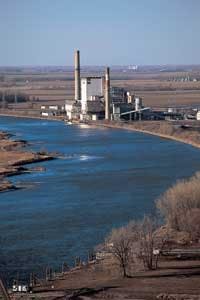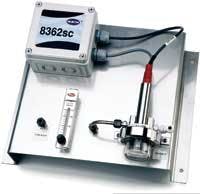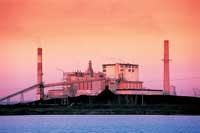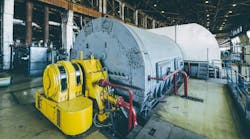Obsessively, relentlessly at your service” - that’s the slogan of MidAmerican Energy Co. and the promise it makes to all of its customers.
No matter what the task, MidAmerican Energy pledges its award-winning team will be on hand to serve over 698,000 electric customers and over 680,000 natural gas customers in a 10,600-square-mile area from Sioux Falls, S.D., to the Quad-Cities area of Iowa and Illinois.
For David Dooley, supervising chemist at the company’s Neal Energy Center-Neal North Plant, just south of Sioux City, IA, the task of protecting his plant’s equipment to keep it in peak operating condition was requiring more obsession and relentlessness than he and his staff had planned. The problem was monitoring and controlling pH to minimize corrosion and keep boilers operating efficiently in an ultrapure water application.
Corrosion, Scaling
At the Neal North Plant, Dooley and his team carefully monitor and control pH based on Electric Power Research Institute (EPRI) Cycle Chemistry Guidelines for both water and steam quality. The guidelines were established to protect the cycle components from corrosion and deposition, including the condensate system, feedwater system, boiler and turbine. The parameters monitored include pH, dissolved oxygen, silica, chloride, sodium, cation conductivity, and others like phosphate, ammonia and hydrazine, depending on what type of treatment chemical program is used.
The parameters were selected because they either relate directly to corrosion and deposition rates (dissolved oxygen, pH, and silica) or they relate to the purity of the water and steam in the cycle (sodium, silica, cation conductivity, chloride) or they relate to treatment chemicals used to affect other parameters (ammonia, hydrazine, phosphate), or some combination of the three.
Even a slight variation from standards in pH can quickly lead to corrosion damage and deposition problems in the three coal-fired generating units that came on-line from 20 to 26 years ago. That type of damage to the drum-type boilers, which operate at 2,400 psig, not only shortens equipment life and creates subsequent operations and maintenance costs from the need to shut down and repair one or more of the plant’s three boilers, the threat of failure poses a safety hazard.
The cost factors involved in unplanned, yet avoidable maintenance tasks include the cost of the maintenance itself, along with the cost of having all or part of a 950 megawatt plant sit idle for repairs. When that happens, customers are deprived of one of the least expensive sources of power available to them, since the plant’s three generating units burn low-sulfur coal from Wyoming’s Powder River Basin and realize production costs lower than both regional and national averages. Taking the Neal North Plant off-line also places larger demand on other parts of the system, including sites generating power from wind, natural gas and oil, nuclear, hydroelectric and biomass sources.
Continuous Analysis
Dooley’s challenge was for his staff to stay on top of closely monitoring pH throughout the plant cycle, along with other key parameters. Most of the parameters, including pH, are analyzed continuously by on-line process analyzers. They are all checked daily by lab technicians in the plant’s laboratory using bench-top instruments.
The challenge of obtaining accurate pH measurements from process analyzers, particularly for high-purity water, has been well documented. The combination of low solution conductivity (or low ionic strength), the potential for both CO₂ absorption (which acidifies the water) and the generation of static charges (also referred to as “streaming potentials,” which create excessive noise or errors in the measurement), present unique challenges when attempting to effectively measure pH in ultrapure water applications. To complicate the problem for MidAmerican, the plant’s old process pH analyzers responded very slowly to pH changes. They also were unable to monitor at even the minimum precision (± 0.05 SU) required by the EPRI standards for pH control.
An opportunity to address this daily challenge presented itself when one of the old pH analyzers failed. It had been used to control chemical pumps to adjust pH and keep it within required parameters. The pH analyzer/controller measures the actual pH value of the process and compares it with the target value or “set point.” If the actual pH is lower than the set point, the controller signals a chemical feed pump to increase its speed, which adds more treatment chemical to the process until the deviation between actual pH and set point is reduced to zero. If the actual pH is higher than the set point the controller reduces the speed of the chemical pump.
Wes Lastine, the plant’s Hach Company service representative, suggested the new Hach 8362sc High Purity Water pH Panel as a replacement. Dooley took advantage of the offer to install and demonstrate the new equipment.
Striving for Accuracy
The MidAmerican team was particularly interested in the measurement accuracy the system provided, enabled by its self-pressurizing reference electrode. The electrode introduces a constant flow of electrolyte into the sample stream, reducing the effects of electrolyte oscillations and subsequent reference junction potential phase shifts found in other systems. The panel also offers accurate temperature measurement that’s so critical for measuring pH for high-purity water, in addition to easy setup and maintenance.
“The new Hach system has worked well,” Dooley said. “It responds quickly to small changes in sample pH, and produces values that are within 0.05 Standard Units (SU) of our laboratory instruments.”
He also noted drift was minimal during the several months the system has been in place, and that the design of the new flow cell makes it easy for his laboratory technicians to access the electrode and immerse it in buffer solution when calibration is required. Instrument setup and calibration proved easy, even intuitive, simply by following the display menu.
“We are now stocking the Hach 8362sc panel, and we intend to use it for all our new process pH measurements,” Dooley said. “I would encourage others who experience difficulty with measuring pH in ultrapure water applications to try (it) for themselves.”
For MidAmerican, this will mean replacing the other, older on-line process analyzers as they fail to ensure all the process readings taken throughout the plant are as fast and accurate as they can be.
Conclusion
The dedication of Dooley, his team, and everyone at MidAmerican to be “obsessively, relentlessly at your service” shows not only in the concern taken to lower costs and improve reliability, but also by being recognized for two consecutive years by J.D. Power and Associates as the Midwest utility with the highest business utility customer satisfaction ranking, as well as the highest ranking for customer satisfaction in the nation in 2005. IWW
The Hach Co. (www.hach.com) is based in Loveland, CO. Contact: 800-227-4224.





